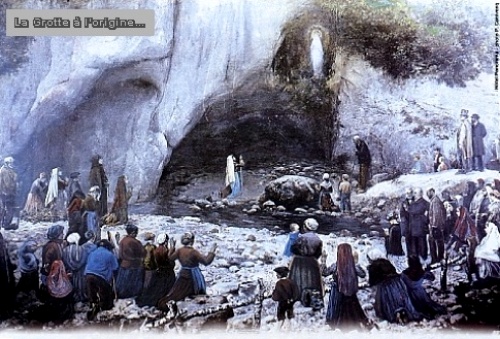(Pastor’s Note from the Mary Immaculate of Lourdes Parish Bulletin for February 12, 2012)

On February 11th we celebrate the patronal feast-day of our parish of Mary Immaculate of Lourdes. One hundred and fifty-four years ago a poor girl named Bernadette Soubirous from the town of Lourdes, France, claimed that she saw a mysterious young girl,
dressed in white, within the rocks of the Massabielle along the River Gave. The report caused a sensation and much controversy
among the Lourdais. In the course of successive apparitions, the mysterious visitor, seen only by Bernadette, revealed to the girl an underground spring by the rocks which began to flow copiously into the River Gave (the famous Lourdes spring). On March 25th, 1858, the visitor gave Bernadette her name: “I am the Immaculate Conception.” After careful investigation, the local Bishop eventually judged the testimony of Bernadette Soubirous as “worthy of belief”. The Church has incorporated a feast of the first apparition of Our Lady at Lourdes into her official liturgy.
One of the objections made to the first promoters of Lourdes was that these outside commentators were superimposing a
sentimentalized and idealized picture of life in the Pyrenees—as if Lourdes was a kind of idyllic, pristine mountain town, solid in its traditions and Christian values, uncontaminated by the currents of godless modernity. Such deliberately crafted sentimentalization, it is true, hardly does justice to the real-world suffering in which Bernadette and her impoverished family lived.
The region of the Upper Pyrenees was generally suffering from worsening economic and social conditions. In 1828, the French government tried to control access to the communal forestland, which covered a third of the mountains. Access to the communal forest, however, was crucial to the survival of the poor. Beginning in the early 1830s armed revolt spread throughout the countryside. It became known as the War of the Demoiselles. Pyrenean men dressed in white after the legendary fairy-spirits who were believed to inhabit the deep woods. They would carry out raids against the forest guards in an effort to recover their historic rights. This civil strife and the government’s attempts to suppress it lasted through the 1850s. By then the women and children carried on the fight by acts of civil disobedience, defiantly taking bundles of wood from the forests despite the penalties which included fines and imprisonment. This was the local world visited by Our Lady in 1858.
